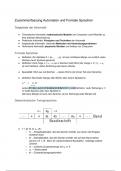Class notes
Vorlesungsmitschrift Automaten und Formale Sprachen
- Course
- Institution
Hier findest du die Mitschrift der Vorlesung Automaten und Formale Sprachen aus dem Sommersemester 22 bei Prof. Dr. Mike Scherfner. Es werden die Relevanten Inhalte der Vorlesung für die mündliche Prüfung definiert und zusammengefasst.
[Show more]



